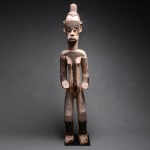Igbo Painted Shrine Sculpture (Alusi), 20th Century CE
Wood
height 165.1 cm
height 65 in
height 65 in
PF.6050
Due to the diversity of the Igbo people, it is impossible to generalize about a pure Igbo art style, which has characteristically been representative of numerous geographical regions. It is...
Due to the diversity of the Igbo people, it is impossible to generalize about a pure Igbo art style, which has characteristically been representative of numerous geographical regions. It is believed that the Igbo people originated in an area about 100 miles north of their current location at the confluence of the Niger and Benue Rivers. The earliest surviving Igbo art forms are from the 10th century (Igbo Ukwu), and the fine quality of those copper alloy castings suggest that Igbo society had already achieved a level of technology rivaling contemporary Europeans. Before the influence of Christian missions, most Igbo practiced some form of ancestor worship, which held that in order to gain success in this world, one must appease the spirits of the deceased. One of the primary ways of showing respect for the dead was through participation in the secret men's society, Mmo, which is the name used only in the northern part of Igbo land. In other parts, similar societies exist under different names.
A large wooden standing figures such as this one probably represents one of the numerous Igbo Alusi, a generic term used to describe the spirit deities that watch over the community to ensure its well-being and continuity. They are grouped together in symbolic families and are kept in special houses and shrines where they are revered. Out of context, it is impossible to determine whether a particular carving represents a major deity or is merely an ancestral family member. In one “family,” different styles may be noticed, for the individual figures are carved at different times and perhaps by different artists. During annual festivals, these figures are taken out of their shrines and paraded through the villages. The abdominal and facial scarifications are typical of Igbo works, occurring on both male and female examples. One can imagine the power and presence of watching such an imposing figure being carried around. Coupled with the energy and excitement of a festival, this event surely must have been quite a spectacle. Although the masses of celebrating people have disappeared, the extraordinary force of this figure is still radiant. Isolated as a solitary example of the Igbo people, one can greatly appreciate the tremendous skill and artistry of the figure and the composition.
A large wooden standing figures such as this one probably represents one of the numerous Igbo Alusi, a generic term used to describe the spirit deities that watch over the community to ensure its well-being and continuity. They are grouped together in symbolic families and are kept in special houses and shrines where they are revered. Out of context, it is impossible to determine whether a particular carving represents a major deity or is merely an ancestral family member. In one “family,” different styles may be noticed, for the individual figures are carved at different times and perhaps by different artists. During annual festivals, these figures are taken out of their shrines and paraded through the villages. The abdominal and facial scarifications are typical of Igbo works, occurring on both male and female examples. One can imagine the power and presence of watching such an imposing figure being carried around. Coupled with the energy and excitement of a festival, this event surely must have been quite a spectacle. Although the masses of celebrating people have disappeared, the extraordinary force of this figure is still radiant. Isolated as a solitary example of the Igbo people, one can greatly appreciate the tremendous skill and artistry of the figure and the composition.



